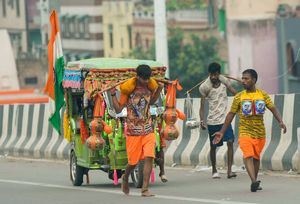It was in the early 1990s that I first noticed the kanwariyas. One man, or two, walking single file along the edge of the Jaipur highway in Gurugram, with a simple rod across their shoulders, from which dangled two simple earthenware pots or water bottles, of the kind children carry to junior school.
They were dressed in ordinary clothes, and often barefoot, or with bandages wrapped tightly around their feet.
Chatting with a couple of them, I learnt they were on a sort of pilgrimage-marathon, and were returning from Haridwar with Ganga-jal in their pots, to offer at their local Shiva shrine. I thought it was an interesting new trend, a blend of sight-seeing, healthy aerobic activity, brotherly camaraderie and a wholesome spiritual quest.
The Jaipur highway passes right outside my township, and over the years, I saw the number of kanwariyas swell. Soon, a camp was set up outside our bit of highway, in a clearing under the shade of the Kikar trees—a jolly little camp, with a stand outside to park your rod-and-water pots, a row of charpais, a makeshift kitchen and devotional music playing from not-very-loud speakers.
Very sanskari. Nothing unmanagebale or worrying about it.
But in the new millennium, with the gradual swelling of both hindutva and unemployment, came, to use a term borrowed fittingly enough from Kaun Banega Crorepati, the bada padhav. This year, over four crore Shiva devotees visited Haridwar in Uttarakhand for the annual Kanwar Yatra. The authorities cleaned up about 30,000 tonne of garbage from the Ganga ghats, markets, parking lots and the roads that cover a distance of 42km called the Kanwar stretch from Har-ki-Pauri.
Reports of blocked highways, traffic snarls, petty violence and accidental death crop up along the route every year. Last year, two factions of kanwariyas clashed, which resulted in one death and fifteen injured. This year, there have been 17 deaths—13 in road accidents and four by drowning. One young pilgrim was electrocuted when a music system on the vehicle they were in came in contact with a high-tension electricity wire in Loni, Ghaziabad. Eight of his companions sustained serious injuries.
So many young men (the number of women making the Kanwar Yatra is minuscule) setting out unsupervised from their villages every year (some for the first time in their young lives) is a recipe for disaster. They are in high spirits, in the mood for adventure, they feel invincible in their saffron tee shirts, with the hand of Shiva hovering over them in protection, and they have absolutely no clue how fast the traffic moves on the highways, and how treacherous the current of the river can get in the monsoon.
On top of that, they’re all eager to go viral. So they’re doing the yatra on skates. On bikes. In impractical costumes. They’re trying to set speed records. They’re taking selfies and shooting themselves doing stunts on their bikes in impractical costumes while setting new speed records. Nobody’s eye is on either the safety element or the hygiene element.
And every night, there are the DJs. A DJ is not a disc jockey or even a person, it is a massive vehicle, usually a tractor plus trollies, stacked high with hundreds of kilos of sound and light equipment and trailed by three or four diesel generator vans. These DJs conduct all night rave parties where hundreds of thousands of young men dance to trance music in the open. Often, two famous DJs from different districts of states will conduct a ‘war of the DJs’. The pollution and commotion is extreme.
I have tremendous love for Bholenath. And I’m all for spiritual quests. But the Kanwar Yatra is spiralling dangerously out of control. We must figure out how to calm it down.
editor@theweek.in


